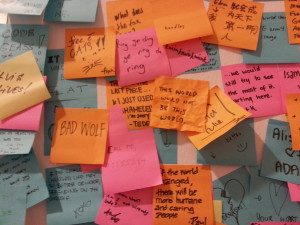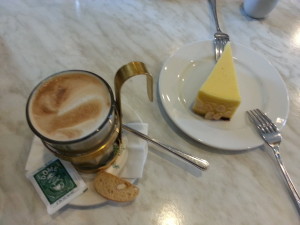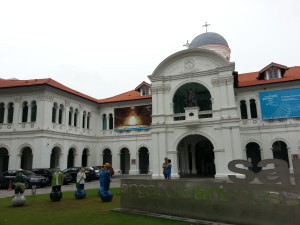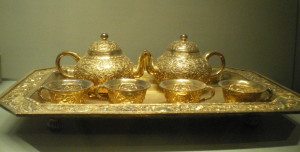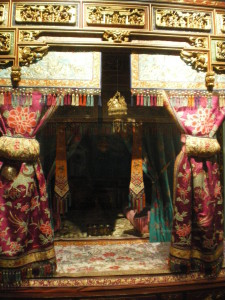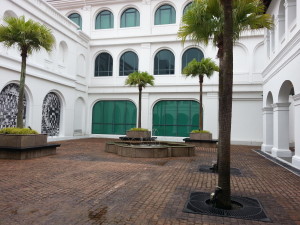 The Culture
The Culture
SAM’s installations change regularly. Singapore is currently hosting its fourth Biennial, a South East Asian contemporary art exhibition, the theme of which is If the World Changed. SAM had some thought- provoking exhibits around this theme.
A traditional Melaccan boat was filled with a thousand bottles, each with a message on the outside. The messages were written by male inmates of Singapore’s prison about their hopes for their time in prison and on their release. It was particularly interesting to see an exhibit giving a voice to prisoners in a country that is known for having severe penalties for breaking the law. I could not help wondering how far messages had been selected on the basis of handwriting, though, as all the messages that were visible were written by prisoners with beautiful handwriting!
In one room visitors were asked to write on post-its their answers to the question “If the world changed…” (although I am not entirely sure that is really a question…). I love anything that gives visitors a chance to write their opinions down as part of a display.
Another exhibition, not part of the If the World Changed installations, gave no titles to artwork in a room. Instead, there were slips of paper on which visitors could write suggestions for a title and slip it into one of several slots placed next to the artworks for the purpose. I was not particularly moved by any of the actual artworks in the room, but really enjoyed the concept. You never really know what you would have thought of a piece of art, or indeed a museum exhibit, if you did not have the preconceptions presented to you in the title. I have heard that the National Museum of Australia chooses not to label exhibits at all, which is perhaps taking this idea too far – I do think titles and labels generally help visitors get more out of the experience of visiting a museum or gallery. However, the installation at SAM was a great way to get visitors to engage with the artworks and work out what the artworks meant to them personally.
SAM also housed one of the most disturbing exhibits I had ever seen in a museum. In a darkened room, hundreds of dolls’ heads had been placed on sticks. Visitors followed a path through the dolls’ heads to reach a shed which had hundreds more (entire) dolls hung up. The dolls had all been thrown away and were taken from a landfill site in the Philippines. One entrance to the exhibit warned that the content could be disturbing, but I think we had the misfortune to wander in through another entrance, so missed the warning!
The Coffee
A branch of the lovely coffee shop Dôme is available to offer refreshment to visitors to SAM. Dôme offers western-style coffees, light meals, juices and smoothies and delicious cakes. I chose a “long macchiato”. I am not entirely sure how it would differ from a latte, which was also available. The coffee was excellent and came in an elegant glass with a pretty holder.
To accompany the coffee, I had half a slice of New York baked cheesecake. I was a little worried about choosing a cake that depended so much on good quality dairy products, but I was not disappointed. The baked cheesecake consistency, which can be difficult to get right, was very good (although to split hairs, it could have been everso slightly moister!). It had a pleasantly lemony undertone and I enjoyed the crunch of the flaked almonds around the cake’s circumference.
The Company
My boyfriend accompanied me on my visit to SAM and Dôme. He had the other half of the baked cheesecake at Dôme, washed down with an iced cappuccino.
Visitor’s View
I have mixed views on modern art in general, sometimes feeling that artists have not put enough thought into conveying meaning through their work. However, much of the artwork I viewed at SAM was thoughtful and thought-provoking. Of course, I have only written about installations and exhibits I was particularly impressed by – some exhibits seemed, to me at least, far less interesting.
The museum has a great space with different galleries, walkways and wings. I liked the way visitors were taken through exhibits – lots of exhibits were behind curtains to create a sense of anticipation and allow for different lighting levels and sometimes visitors passed through multiple curtains and exhibits (which, incidentally, was how we ended up in a roomful of severed dolls’ heads without warning!).
SAM could be completely different in a few months’ time, as installations change regularly. However, I suspect that this feature was part of the reason all the exhibits felt fresh and relevant and that visitors would be likely to have an equally engaging experience whenever they visited.
The Singapore Art Museum, 71 Bras Basah Rd, Singapore 189555, visited on 17 November 2013. Admission is SG$10 for adults, SG$5 for foreign students and senior citizens, which includes admission to the museum’s annex, SAM at 8Q, on the same day. A SG$10 ticket granting admission to the Singapore Art Museum, the Singapore National Museum and the Peranakan Museum, valid for one visit to each, to be used before 16 February, is available until 16 February.
